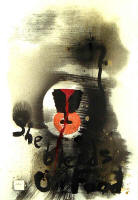 A selection of paintings, January-May, 2002. A selection of paintings, January-May, 2002.
Click
here for paintings June-November 2002
Unless otherwise noted,
all paintings are acrylic on paper, 44 x 30 inches
Scroll down for the paintings, click the image
for a larger view.In 2002, I often tried to work with images that would
originate in texts, either words that came to mind during the day I
began the painting, or other old texts that I remembered from long
ago. One painting begun from a text that came to mind during the
day, but changed in the painting, is
#6, January 2002.
The painting is a second state of a painting I made for the What Is
Art For? conversation on the occasion of the What is Art For?
show at the Oakland Museum in1999. Then, it was a chalice made
in recollection of the chalice collages and paintings I had made in
1958. However, as I worked on the 1999 painting in January 2002,
the painting seemed to me to say what its meaning is now... a mother's
sorrow as her children grow in the pains of life: "Mother, She bleeds
our food." Another painting,
#4, November 2002
dealt with the same themes: "The lost home in the heart will never
return forgotten in the longing in a mother's voice." The
dark bar was our death, the red spot was a mother's longing for her
children and our own longing for her. However, perhaps the most
obvious of the text-based paintings--#12c, February, was
straight from a scribbled text written ten minutes before I began to
paint out of despair over the monotony of what current criticism would
call my "artistic practice."
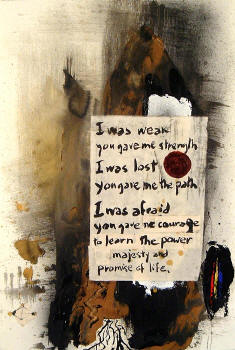
#4, January 2002 |
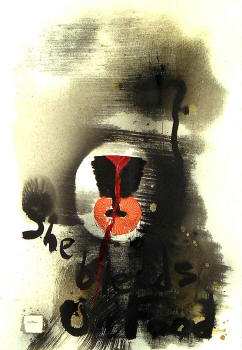
#6, January 2002 |
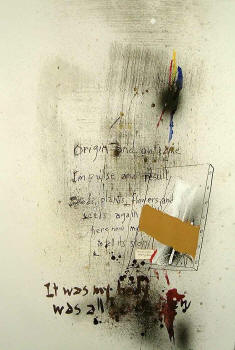
#16, January 2002.
"Origin and Outcome"
|
|
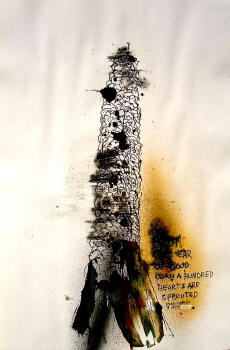
#4, February 2002 |
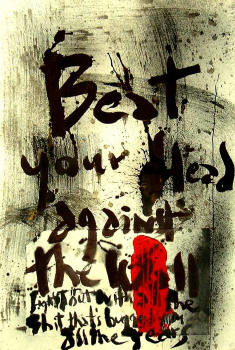
#12c, February, 2003 |

#3, April 2002.
22 x 15 in. |
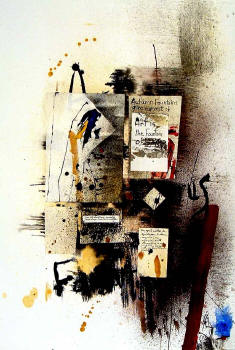
#4, April 2002--State 2
|
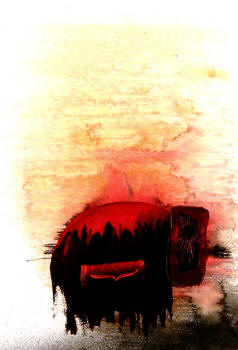
Second State of #16, May 2002
22 x 15 in.
Collection di Rosa Preserve. |
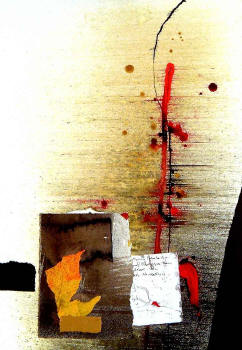
#18, May 2002
22 x 15 in. |
|
Text of #17, May 2002. Morning Service
He wondered if what he was about to do in this way of art—his
private union and worship of the power of life—was permissible.
Permission comes only from that power itself, and permission was
granted.
He remembered how sometimes the Chinese scholar—a
mandarin like himself of so much learning, authority and isolation—in
the silence of his studio and surrounded by the tools not only of his
first studies but also of his subsequent social ascent…the brush and
ink, the paper and inkstone, and by curious things and bits of stone
his friends of past times had given him, a water-dropper shaped like
one of the Taoist peaches of immortality, a fragment of jade with the
lines of the mountains of the Western Paradise.
He remembered how sometimes it was for the
Chinese mandarin that accidents of nature revealed to the longing mind
the truths of places and things.
So for him it had been when last night he made
the sun of eternity beyond the gates of Beulah Land and it was so wet
and bleeding of itself in whatever way the accidents of causation did,
and when this morning he saw the stains upon the paper where they had
run and dried and saw in them his own journey and its calling, thus as
for the Chinese scholar to whom sometimes the marks in a rock showed
the path of life, so sometimes for him a stain, a bleed or blob of
paint became the actual of what had been only words, “That this light
which once so fell will ever so fall, even to the final dust.”
And on this paper, then, he found his prayer and
truth, saw his words and touch and shining dust.
|
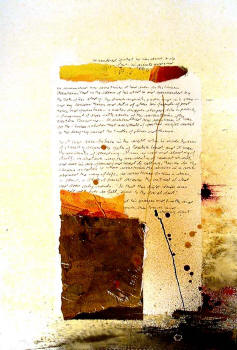
#17, May 2002
22 x 15 in. |
| |
Click
here for paintings June-November 2002 |
|
|
|